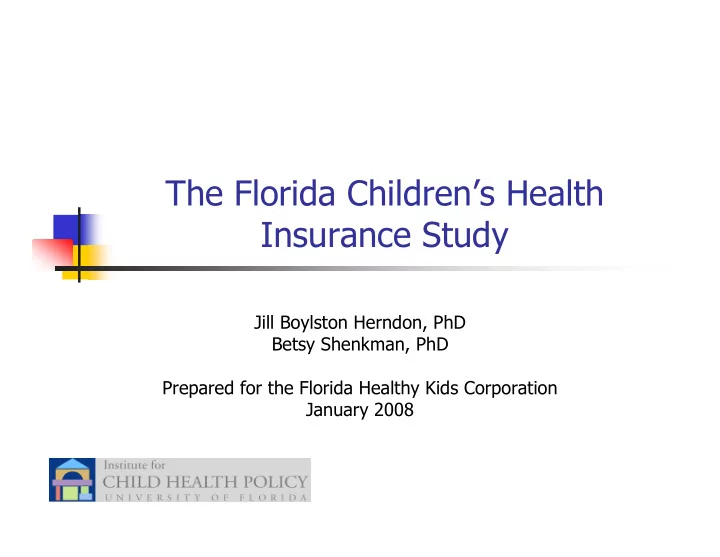

The Florida Children’s Health Insurance Study Jill Boylston Herndon, PhD Betsy Shenkman, PhD Prepared for the Florida Healthy Kids Corporation January 2008
Study Objectives To develop statewide estimates of uninsured children in Florida. To compare the sociodemographic and health characteristics of insured and uninsured children in Florida. To estimate KidCare Program eligibility.
Survey Instrument Information collected on the following: Enumeration of household members including demographic characteristics and relationship to one another Health insurance coverage of each household member Children with Special Health Care Needs (CSHCN) screener for child with the greatest health care needs Employment and earnings information
Survey Methods Random dialing digit survey of households in each of Florida’s 67 counties Only households with children under age 19 were eligible to complete the survey Oversampled counties at higher risk for having uninsured children with survey results weighted by the appropriate universe size of children in each county Interviews conducted in English, Spanish, and Creole from August 2007 – November 2007 Average interview length of 25 minutes
Sample Size Targeted number of completed interviews: 2,400 Reporting on: 2,220 interviews (households) representing 4,202 children
Results: Percentage of Uninsured Children Uninsured Children in Florida 2002 15.0% 1 2004 12.1% 2 2007 12.6% 3 1 Florida Children’s Health Insurance Survey, 2002 2 Florida Health Insurance Survey, 2004 3 Florida Children’s Health Insurance Survey, 2007
Results: Children’s Health Insurance Coverage in Florida, 2007 Uninsured, 12.6% Other, 1.0% Medicare, Military & Other Public, 4.9% Employment Based, 50.3% Medicaid & Title XXI, 24.8% Private, Individually Purchased, 6.4%
Results: Length of Time with and without Coverage 62% of uninsured children in Florida were without coverage for more than one year. 87% of insured children had coverage for more than one year.
Results: Age and Health Coverage 12-18 Years 57% 27% 16% 5-11 Years 55% 33% 12% 0-4 Years 61% 32% 8% Private Public Uninsured
Results: Race/Ethnicity and Health Coverage 32% 46% 22% Black Non-Hispanic Hispanic 39% 42% 19% White Non- 71% 22% 8% Hispanic Private Public Uninsured
Results: Income and Health Coverage >300% FPL 88% 10% 2% 67% 23% 11% 201-300% FPL 151-200% FPL 39% 40% 22% 101-150% FPL 16% 61% 23% <100% FPL 16% 61% 23% Private Public Uninsured
Results: Special Health Care Needs and Health Coverage Three Screeners Met 38% 54% 8% Two Screeners Met 55% 33% 12% One Screener Met 55% 37% 8% 66% 21% 13% No Screeners Met Private Public Uninsured
Results: Parent Employment and Insurance Status and Health Coverage 84% of insured children and 73% of uninsured children have at least one employed parent in the household. 84% of insured children have an insured parent in the household, whereas only 24% of uninsured children have an insured parent.
Results: Parent Employment Characteristics and Health Coverage Among children with an employed parent in the household: Children whose parents are self-employed are more likely to have public coverage (38%) or be uninsured (15%) than children who have at least one parent who works for an employer (22% public coverage and 10% uninsured). 25% of uninsured children have parents who are employed part-time, compared to 9% of insured children. 14% of uninsured children have parents who have only seasonal employment compared to 6% of insured children.
Results: Usual Source of Care 58% of uninsured children had a usual source of care (USC) compared to >90% of insured children. Among children with a USC, uninsured children were more likely to use walk-in clinics or the ER as the USC and less likely to use a doctor’s office compared to insured children. Among children without a USC, the reason cited most often for not having a usual source of care was that the child is seldom sick. However, families of uninsured children were more likely to cite lack of health insurance and the cost of care as reasons.
Results: Knowledge of KidCare Programs 76% of all respondents indicated that they had heard of at least one of the following: KidCare, Healthy Kids, MediKids, or the Children’s Medical Services Network. Households with uninsured children were more likely to have heard of KidCare and less likely to be familiar with specific program components compared to households whose children have health coverage. Families were most likely to learn about KidCare from their children’s school, family or friends, or a doctor’s office. Families with uninsured children were more likely to report having learned about KidCare from their children’s school or prior program experience.
Results: Estimates of KidCare Program Eligibility among Uninsured Children Not Eligible; 153,440; 28% 72% of uninsured children are eligible for KidCare coverage Medicaid; 268,520; 49% Medicaid Healthy Kids MediKids Not Eligible MediKids; 10,960; 2% Healthy Kids; 115,080; 21% Approximately, 3% of children who are uninsured and eligible for free or subsidized coverage also meet CMSN clinical eligibility criteria.
Results: Characteristics of Uninsured Children Eligible for Florida KidCare 20% of children who are uninsured but eligible for free or subsidized KidCare coverage are ages 0-4, 35% are ages 5-11, and 45% are ages 12-18. 40% of eligible but uninsured children are non-Hispanic white, 37% are Hispanic, and 22% are non-Hispanic black.
Summary 12.6% (approximately 548,000) of Florida’s children were uninsured in 2007. The following segments of the child population are at disproportionate risk for being uninsured: children ages 12- 18, Hispanic children, non-Hispanic black children, children in households below 200% of the FPL, and children whose parents are uninsured. Uninsured children are more likely to have parents who are self-employed, employed part-time, or employed seasonally than insured children.
Summary (cont.) Uninsured children are less likely to have a usual source of care and more likely to use the ER and walk-in clinics as their usual source of care than insured children. There is good name recognition of the Florida KidCare Program. Households with uninsured children were more likely to have learned about KidCare from their children’s school or having prior program experience than those without uninsured children. 72% of uninsured children in Florida are eligible for KidCare coverage.
Recommend
More recommend